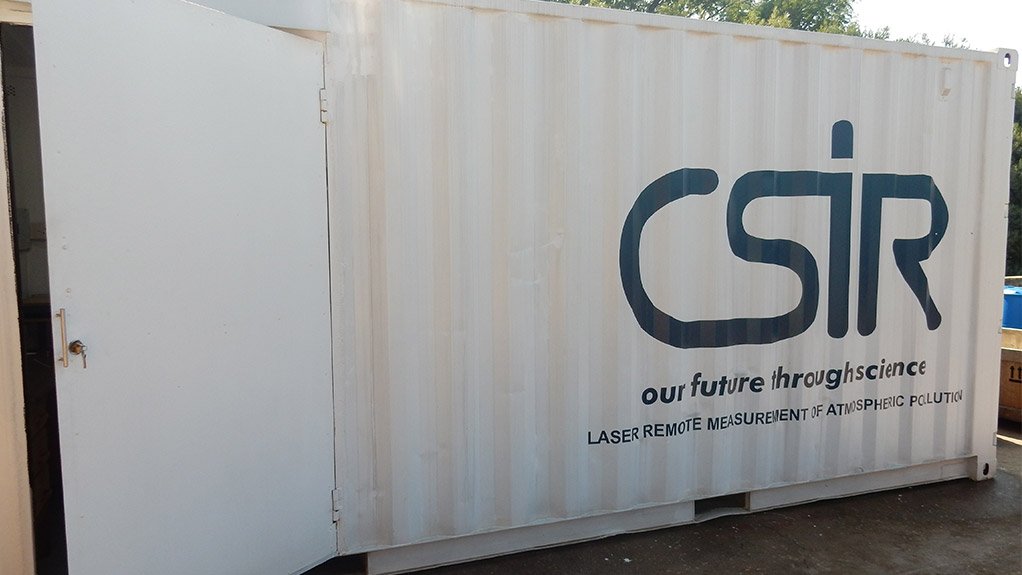CSIR-designed LiDAR mobile system to monitor air quality in uMhlathuze Municipality
This article has been supplied as a media statement and is not written by Creamer Media. It may be available only for a limited time on this website.
The Council for Scientific and Industrial Research (CSIR) has designed and constructed a mobile light detection and ranging (LiDAR) lab that will be operating at the University of Zululand, the second university to have and operate a LiDAR system within in its premises in South Africa.
This atmospheric laser radar is a state-of-the-art instrument that uses the most powerful techniques for active remote sensing of the earth’s atmosphere. It uses laser pulses to measure atmospheric constituents, such as aerosols particles, water vapour, clouds and ice crystals, and it even trace gases. The CSIR-designed mobile LiDAR system will be used to provide profiles of aerosols from the surface to upper troposphere in the uMhlathuze region.
The research project, led by Dr Nkanyiso Mbatha from the University of Zululand (UNIZULU), in collaboration with Prof Sivakumar Venkataraman from the University of KwaZulu-Natal (UKZN), is important because LiDAR measurements contribute significantly to topics such as weather forecasting, climate modelling, and environmental monitoring.
Dr Mbatha says the uMhlathuze local municipality is a region with high industrial activity, which could lead to changes in local air quality and other environmental issues. The locally based mobile LiDAR system will assist the municipality in monitoring the air quality of the region.
In 2016, the CSIR received a request from Mbatha for laser equipment for a LIDAR programme. The emerging researcher from UNIZULU has been working closely with Venkataraman from the physics department of UKZN, studying high-altitude atmospheric phenomena.
“Dr Mbatha’s interest was to investigate the chemical composition of the troposphere over the City of uMhlathuze, using different ground-based LiDAR system, space-borne systems and model simulation techniques.
Having a ground-based LiDAR system in Richards Bay will therefore contribute to an already existing network of LiDAR systems and will be used to specifically study the atmosphere above Richards Bay, which could be negatively affected by industrial activity in the region,” said Hardus Greyling, National Programmes Manager of the CSIR National Laser Centre.
The CSIR, through the CSIR National Laser Centre Rental Pool Programme provides laser equipment and technical support to South African universities and their research and development programmes. Over the past 18 years, the programme, which is funded through a directed parliamentary grant from the Department of Science and Technology (DST), has supported a large number of projects at universities across the country.
The programme aims to provide specialised laser equipment to the research community, in an effort to support research projects which result in new knowledge generation, as well as the training of Master’s and PhD students.
“In line with this mandate, the programme agreed to construct a LiDAR system to support research endeavours at UNIZULU. The constructed a mobile laboratory which is housed in a container and will be moved to the campus,” added Greyling.
CSIR technician, Henk van Wyk and lab administrative assistant, Bafana Moya, designed the layout of the mobile laboratory, in consultation with Mbatha and Venkataraman. The construction of the facility began in the 2017/18 financial year.
The system was tested and evaluated during a visit to the CSIR by the two KwaZulu-Natal based researchers and satisfactory measurements up to heights of 15 km were made. The system will now be moved to the UNIZULU campus, where it will be commissioned by the team in early July 2018.
“With the LiDAR system being brought to this area for the first time, we are anticipating that it will draw a lot of interest from the public and the students of the university, particularly the physics department.
Therefore, to introduce the system to the public, we plan to run exhibitions for the community and run classes that will teach students about lasers and their applications. We will also be working closely with air quality monitoring associations within the area,” says Mbatha.
Comments
Press Office
Announcements
What's On
Subscribe to improve your user experience...
Option 1 (equivalent of R125 a month):
Receive a weekly copy of Creamer Media's Engineering News & Mining Weekly magazine
(print copy for those in South Africa and e-magazine for those outside of South Africa)
Receive daily email newsletters
Access to full search results
Access archive of magazine back copies
Access to Projects in Progress
Access to ONE Research Report of your choice in PDF format
Option 2 (equivalent of R375 a month):
All benefits from Option 1
PLUS
Access to Creamer Media's Research Channel Africa for ALL Research Reports, in PDF format, on various industrial and mining sectors
including Electricity; Water; Energy Transition; Hydrogen; Roads, Rail and Ports; Coal; Gold; Platinum; Battery Metals; etc.
Already a subscriber?
Forgotten your password?
Receive weekly copy of Creamer Media's Engineering News & Mining Weekly magazine (print copy for those in South Africa and e-magazine for those outside of South Africa)
➕
Recieve daily email newsletters
➕
Access to full search results
➕
Access archive of magazine back copies
➕
Access to Projects in Progress
➕
Access to ONE Research Report of your choice in PDF format
RESEARCH CHANNEL AFRICA
R4500 (equivalent of R375 a month)
SUBSCRIBEAll benefits from Option 1
➕
Access to Creamer Media's Research Channel Africa for ALL Research Reports on various industrial and mining sectors, in PDF format, including on:
Electricity
➕
Water
➕
Energy Transition
➕
Hydrogen
➕
Roads, Rail and Ports
➕
Coal
➕
Gold
➕
Platinum
➕
Battery Metals
➕
etc.
Receive all benefits from Option 1 or Option 2 delivered to numerous people at your company
➕
Multiple User names and Passwords for simultaneous log-ins
➕
Intranet integration access to all in your organisation





















